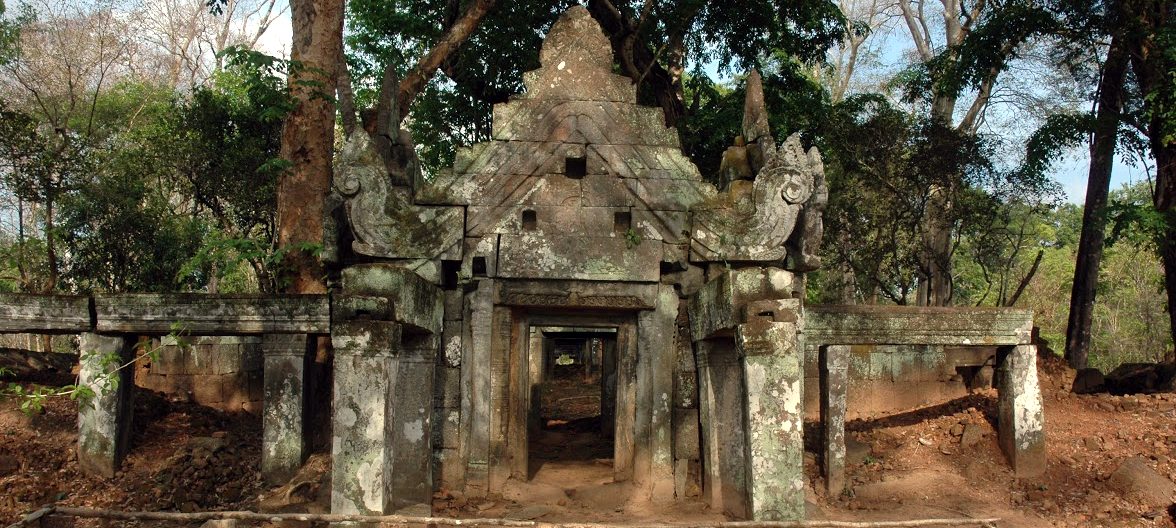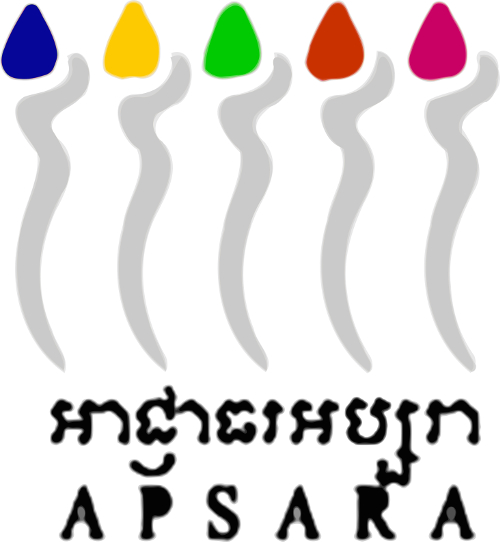Archaeology
Excavation in Prasat Krachap
The Hungarian Indochina Company conducted the first exploratory excavations in the precinct of Prasat Krachap in March and April 2011, in in cooperation with specialists from APSARA, the Cambodian authority for the protection of cultural heritage. When we selected the area for exploration, we sought a site that was in some respect special among the monuments.

We finally chose Prasat Krachap, dedicated to the god Vishnu, some 200m northwest of the large reservoir. In addition to having the largest number of Old Khmer and Sanskrit epigraphs, the temple is also architecturally unique with its two enclosure walls and five internal brick towers. The temple is bordered on three sides by three small artificial ponds. The entrance was probably on the western side, where it also has an entrance building that stands outside the enclosure wall.
So far, the research has primarily focussed on the relationship between the temple and its surroundings: whether there was a secular settlement providing services to the temple in the vicinity. We selected the locations for the probes based on the results of a preliminary site inspection. During that inspection, we collected a large number of ceramic finds from the surface, including the area of the ruins on the other side of the road running in front of the temple.
During the two-month excavation we opened a total of 14 trial trenches over an area of 45 square metres, but we also performed a systematic site survey of the entire area of the temple, covering some 12,000 square metres. The excavation yielded information about the internal layers of the area, as well as the surroundings of the buildings. The probes revealed that Prasat Krachap had been built on a natural hill oriented north to south, on its western slope. Presumably, the internal group of buildings was completed first, as construction rubble from them was used for the foundations of the external buildings, the enclosure wall and the entrance pavilion. The excavation also made it clear that the layout of the temple is more complex than previously assumed. The artificial ponds around the temple were probably created during a later phase.
During the site inspection and the probing we also identified the remains of a settlement to the north of the Prasat group of buildings. The hearth and the ceramic fragments found there indicate that there was a village community near the temple.
Further research plans
Our research plan features the systematic archaeological exploration of the entire temple and a part of its environment. We intend to conduct the archaeological research over the next five years in cooperation with APSARA Authority.
However, before opening larger surfaces up, we shall perform a geophysical survey of the area based on the results of the probes. We plan to extend the survey over the immediate and wider surroundings of the temple to a distance of 200-300 metres where, we presume, there was active life and the archaeological material indicates the presence of further remains of buildings and settlements.
We assume that the geophysical survey will allow us to identify some buildings that are only partially known so far, such as the pavilion on the western side, and we are also likely to gather unique information about the residential area that once surrounded the Prasat, its underground features and the foundation structures of now vanished buildings constructed from perishable materials.
Parallel with that work we shall also perform a geodetic survey of the entire area and the buildings, which will also have to include a survey of the surrounding area and detailed descriptions of the buildings as historic monuments. In addition, we prepare a conservation plan for the temple and, prior to the commencement of archaeological exploration, we shall perform the most urgent preservation work. The conservation of Prasat Krachap will be conducted after the archaeological research is completed.
As an important part of the research programme, we shall present the tools, methods and systems of documentation used in the research to our Khmer colleagues at APSARA Authority in the form of on site workshops, to facilitate their learning of how to use non-destructive research methods and tools in practice and to explore the possibilities of those methods in archaeological research.
Cooperation with the APSARA Authority
A royal edict issued in 1995 founded the APSARA Authority for the protection of cultural heritage sites in Cambodia. This was necessitated by Angkor being declared a World Heritage site and the fact that scientific research and conservation work was beginning at Angkor with the participation of international organisations. The cultural heritage protection authority is under double supervision by the Board of the Council of Ministers and the Ministry of the Economy and Finance. The authority was granted extended powers in 1999. Its tasks include protection, management, care, supervision, research, and the conducting and coordination of conservation work at the Angkor heritage sites, as well as at the other World Heritage sites in Cambodia and at the monuments of the Funan and Chenla Kingdoms and the Khmer Empire. In addition, it also protects the natural environment of various areas, preventing illegal deforestation and occupation of land, arranging financing for the maintenance of areas to be protected and also issuing permits for supervising scientific research and conservation work conducted in heritage and archaeological areas.
The Hungarian Indochina Company has been conducting its scientific research and archaeological exploration in cooperation with APSARA since the outset of the Koh Ker Programme. Cooperation takes various forms, from obtaining permits for the research efforts, through professional consultation, to joint research work. In order to implement the programme, commenced in 2008, we initially concluded a three-year cooperation agreement with the APSARA Authority, which was extended for a further five years in 2012. The trial exploration within the precint of the Prasat Krachap temple in Koh Ker in 2011 was an excellent example of cooperation: the work was conducted by our archaeologists and Khmer specialists. During the research, in addition to the exchange of professional experiences, collegial relationships and personal friendships were also formed. During the next five years, we intend to maintain and expand those relationships while also introducing training for a new generation of experts, providing specialist education and site experience opportunities for the archaeologists of the future at the excavation sites. In addition, we also intend to conduct conservation and preservation work in cooperation with the specialists of APSARA in tandem with the exploration of the Prasat Krachap temple.
